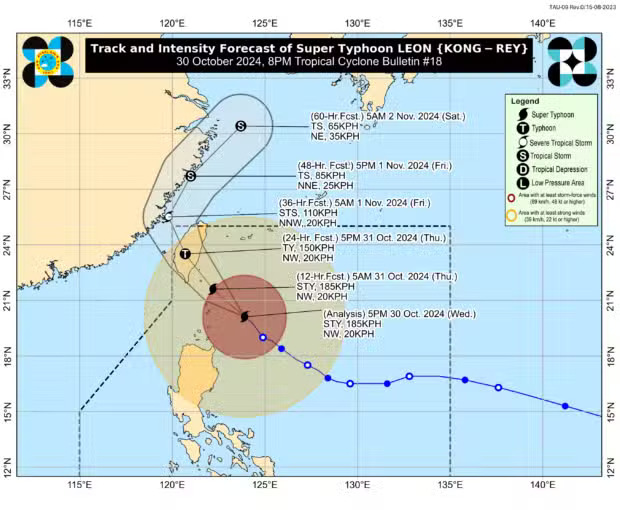Super Typhoon Leon, known internationally as Kong-Rey, is rapidly approaching the northernmost province of Batanes in the Philippines. The Philippine Atmospheric, Geophysical and Astronomical Services Administration (PAGASA) keeps Tropical Cyclone Wind Signal No. 4 in place as the typhoon continues its path toward the area. The weather agency announced this situation on Friday evening, indicating that there is a possibility of raising the signal to TCWS No. 5 depending on the typhoon’s trajectory.
Leon has intensified as it moves closer, creating hazardous conditions for those living in the affected regions. The threat of very strong winds and torrential rains has led local authorities to urge residents to take necessary precautions for their safety. The National Disaster Risk Reduction and Management Council (NDRRMC) is actively monitoring the situation and coordinating with local governments to ensure the readiness of resources for any emergency response required.
The government has ordered relevant agencies to remain vigilant and prepared for any developments. Residents in Batanes and nearby areas have been advised to stay informed about weather updates and follow instructions from local authorities. Many communities are on high alert, with emergency plans in place to evacuate and provide shelter to those in need.
According to PAGASA, the center of Super Typhoon Leon was located several kilometers from the Batanes islands, moving at a steady pace. With maximum sustained winds reaching over 200 kilometers per hour, the storm presents significant risks to infrastructure and agriculture in the region. The agency warns that storm surges, flooding, and landslides are potential threats as the storm’s impact intensifies.
Schools in the affected areas have been closed, and flights have been canceled as part of precautionary measures. The local government units have established community evacuation centers and have mobilized emergency response teams. These centers are prepared to accommodate thousands of residents, providing them with essential needs during the storm’s onslaught.
Meanwhile, the NDRRMC has confirmed that it is in constant communication with the Armed Forces of the Philippines, the Philippine Coast Guard, and other relevant agencies. The objective is to facilitate a coordinated response in case of any emergencies arising from the typhoon. Relief goods and emergency supplies are strategically positioned to ensure swift distribution when necessary.
Economic activities in regions expected to be affected by Leon have been temporarily halted. Businesses and local industries are bracing for possible disruptions. The agricultural sector, in particular, fears losses due to the storm’s potential to damage crops and livestock.
Despite the looming threat, the community’s resilience shines as neighbors rally together to support each other in preparation for the typhoon. Volunteers have been assisting in securing homes and public facilities, ensuring that everything is well-fortified against the adverse weather.

